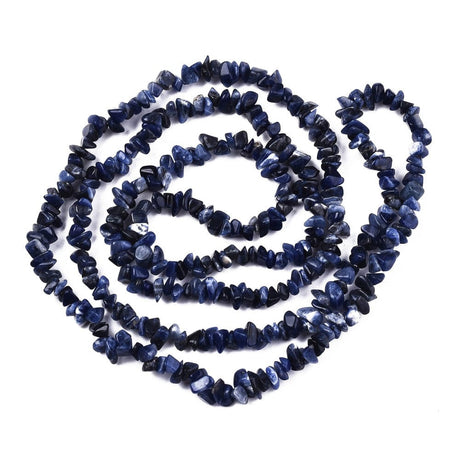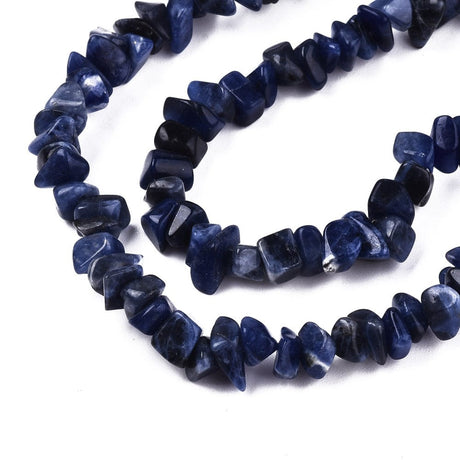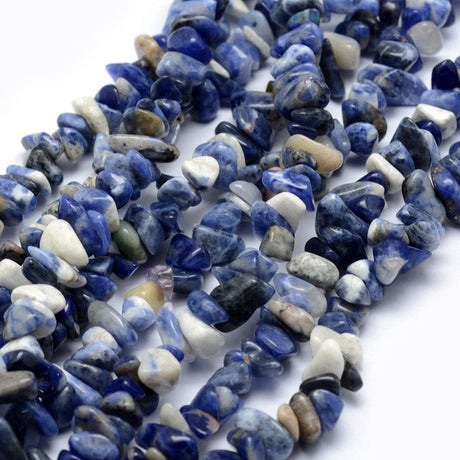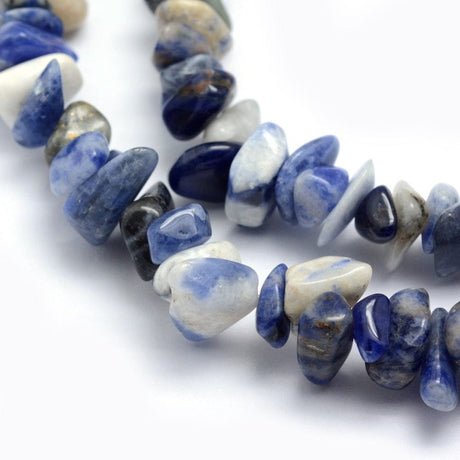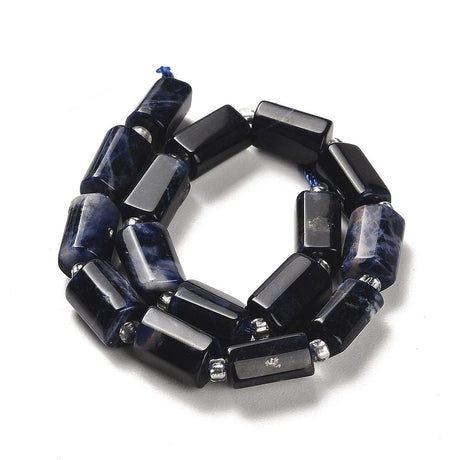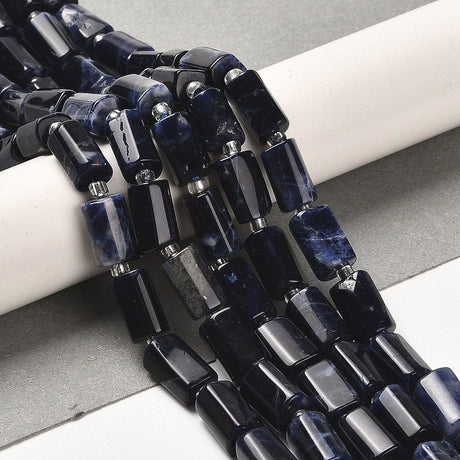
The Fascinating World of Sodalite: A Comprehensive Guide
Sodalite is a fascinating mineral known for its deep royal blue color and is a coveted gemstone in jewelry and adornment. This unique mineral is also found in shades of gray, yellow, green and pink, often marbled with white veins or flecks, adding to its distinctive appearance. Sodalite was discovered in the early 19th century and quickly gained popularity not only for its beauty, but also for its unique properties and applications.
What is a sodalite?
Sodalite belongs to the feldspathoid mineral group and is characterized by its high sodium content. Its deep blue color is primarily due to the presence of trapped sulfur clusters that are integrated into its chemical structure. Despite its beauty, sodalite is relatively fragile with a hardness of 5.5-6 on the Mohs scale, making it less durable than other gemstones like sapphires and diamonds.
One of the most fascinating properties of sodalite is its fluorescence. If you're lucky, shining a UV light on a sodalite will cause the stone to fluoresce orange, a property that is clearly visible in dark environments. In addition, another sodalite variety known as Hackmanite can also change color when exposed to sustained sunlight.
Here is an overview of sodalite's key information:
Mineral: Feldspathoid (Na₈(Al₆Si₆O₂₄)Cl₂)
Hardness: 5.5-6 on the Mohs' scale
Crystal system: Cubic
Colors: Blue, gray, yellow, green, pink, colorless, white, red
Gloss: Glassy, hazy
Transparency: Transparent to opaque
Origin: Canada (Ontario, Quebec), Namibia, Brazil, Russia, USA, Greenland, Afghanistan, Myanmar
Characteristics: Improves communication, intuition, emotional balance, reduces stress and anxiety, promotes creativity and spirituality
Uses: Jewelry (cabochons, beads, sculptures), decorative objects, crystal healing
Due to its beautiful appearance, sodalite is widely used in jewelry. Sodalite is commonly formed into cabochons, beads and decorative objects. Lower quality sodalite, which can exhibit more marbled or less vibrant colors, is often used in intarsia workmosaics and as a decorative stone in various architectural applications.
Sodalite's Fascinating Colors:
Sodalite is known for its deep royal blue color, but can also be found in a variety of other shades, each bringing its own beauty and symbolism. These colors reflect sodalite's diversity and appeal in jewelry and decorations.
The Most Well Known Sodalite Colors:
Blue: The most common color for sodalite, symbolizing peace, intuition and spiritual connection. Blue sodalite is said to enhance communication and promote clarity and rationality.
Gray: A subtle and sophisticated color associated with balance and grounding. Grey sodalite can help stabilize emotions and promote a sense of inner peace.
White: Often marbled with blue, symbolizing clarity, purity and truth. White sodalite brings a sense of spiritual awakening and inner peace.
Other Sodalite colors:
Pink: A rare color variation that symbolizes love, care and compassion. Pink sodalite can bring emotional support and promote self-acceptance.
Yellow: An energetic and encouraging color that symbolizes joy, optimism and creativity. Yellow sodalite can inspire new ideas and promote positive energy.
Green: A color that symbolizes growth, harmony and balance. Green sodalite can help bring stability and healing.
Mineral Content and Light Refraction:
The color and appearance of sodalite depends on several factors:
Mineral content: Sodalite is primarily composed of sodium aluminum silicate with chlorine (Na₈(Al₆Si₆O₂₄)Cl₂). The presence of sulfur clusters (S₃- and S₄-) gives the blue color.
Light refraction: Sodalite has a glassy and sometimes hazy sheen and its structure can fluoresce orange under ultraviolet light. This fluorescence effect can highlight different shades depending on the angle of light.
Origin of Sodalite - Where is Sodalite found in the world?
Sodalite forms in silica-poor igneous rocks such as nepheline syenites and phonolites. These geological environments create the necessary conditions for the mineral to crystallize. Sodalite is often found together with other minerals such as nepheline and can crinite.
Sodalite is found in different parts of the world and each region produces stones with unique shades and patterns. The most well-known sources of sodalite are:
Canada: Especially in Ontario and Quebec, where large deposits are mined. Sodalite from Canada is known for its deep blue colors and excellent quality.
Namibia: Known for sodalite with intense blue hues and often with a more pronounced fluorescence under ultraviolet light. These stones are sought after for their bright color and fine structure.
Brazil: Produces sodalite in various colors, including blue, gray, and green. Brazilian sodalite is often used in jewelry and decorative objects due to its beautiful color play and patterns.
Russia: Sodalite from the Kola Peninsula is famous for its varied colors and high quality. These stones are often used in artistic and decorative applications.
UNITED STATES: Deposits in Maine and Arkansas are known for their quality stones used in both jewelry and decorative objects. American sodalite often has a clear blue color with white marbling.
Greenland: Known for rare and beautiful sodalite stones that often have unique color patterns. Greenlandic sodalite is highly valued by collectors and in the jewelry industry.
Afghanistan and Myanmar: These regions produce sodalite with special color tones and qualities that make them popular in the gemstone market.

Types of Sodalite and their Geographical Origin:
Blue Sodalite: The most common type found mainly in Canada, Namibia and the United States.
Gray and Green Sodalite: Found in Brazil and Russia, these variations are often used in decorative purposes and artistic works.
Pink Sodalite: Rarer color variations found in Brazil and Russia, known for their unique beauty and use in high-end jewelry.
Multicolored Sodalite: Multi-colored stones found in Greenland and Namibia, prized for their unique patterns and beauty.
Hackmanite: A sulfurous variety of sodalite known for its tenebrescence, the ability to change color upon exposure to sunlight or ultraviolet light. Hackmanite is found in Greenland, Canada, Russia, Afghanistan and Myanmar. This type is particularly prized by collectors due to its rarity and fascinating properties.
Sodalite Meaning and Properties
Sodalite is known for its many metaphysical and healing properties, which have made it a popular stone among crystal users and collectors. Here is an elaboration of the most common associated properties:
Communication: Sodalite is said to improve communication and help express thoughts and emotions clearly. It can support those who need to strengthen their ability to communicate effectively, especially in public speaking or difficult conversations.
Intuition: Sodalite is associated with strengthening intuition and inner wisdom. It can help open the mind to new ideas and promote deep inner reflection, making it a useful stone for those seeking spiritual growth and insight.
Emotional balance: Sodalite has a calming effect on the mind and can help reduce stress, anxiety and fear. It promotes emotional stability and calm, making it a good support during periods of emotional turmoil.
Rational thinking: Sodalite is known to enhance logical thinking and rational decision-making. It can help structure thoughts and promote clarity, making it easier to solve problems and make informed decisions.
Self-confidence and self-acceptance: Sodalite is said to increase self-confidence and self-esteem. It can help promote a sense of self-acceptance and self-love, making it easier to stand by your beliefs and act on your values.
Spiritual connection: Sodalite promotes spiritual awakening and connection to higher consciousness. It can help open up spiritual experiences and strengthen the connection to the spiritual plane, making it a valuable stone for those seeking to develop their spiritual practice.
Healing properties: Sodalite is said to have several physical healing properties, such as strengthening the immune system, regulating metabolism and improving digestion. It can also help relieve throat problems and improve the function of the lymphatic system.
Sodalite in jewelry making:
Sodalite can be found in a wide variety of jewelry, including necklaces, bracelets, rings, and various earrings such as hoops and ear chains. Sodalite can be combined with other semi-precious stones to create unique and beautiful jewelry. Below you'll find 8 ways to work with sodalite in your jewelry making.
1. Necklaces with sodalite:
Sodalite necklaces can range from simple beaded necklaces to more complex designs with pendants and charms. The deep blue color makes it perfect for statement pieces that can be worn alone or layered with other chains.
2. Bracelet with sodalite:
Sodalite bracelets can be made in many styles, such as beaded bracelets, cuff bracelets and charm bracelets. Sodalite beads combined with silver or gold details can create an elegant and timeless look.
3. rings with sodalite:
Sodalite rings can range from simple rings to more elaborate designs with intricate settings. Combinations with diamonds or other semi-precious stones can add an extra elegance to your jewelry.
4. Earrings with sodalite:
Sodalite earrings come in many shapes and sizes, from small studs and stud earrings to large drop earrings. They can be simple and minimalist or more elaborate, often combined with other semi-precious stones to create a unique look.
5. Pendant with sodalite:
Sodalite pendants can be simple, highlighting the natural beauty of the stone, or more complex with detailed settings and set with other stones. They work well both as solo pendants and combined with other elements in a necklace or bracelet.
6. Brooches with sodalite:
Sodalite brooches can add a classic touch to any outfit. They can be simply designed or incorporated into more complex brooches with different compositions of gemstones.
7. Anklets with sodalite:
Sodalite can also be used in anklets to add a subtle pop of color to your outfit. Combining sodalite beads with other small charms can create a light and feminine look.
8. sodalite charms:
Sodalite charms can be added to bracelets, necklaces or even bags to add a personal touch. The small stones can be simple or decorated with small metal details to give your charm an extra sparkle.
Sodalite
View all-
Sodalite Beads, King Blue, Round, 6mm
★★★★★(88)107 krUnit price /UnavailableVery low stock (1 unit) -
-
Sodalite, dark blue, frosted, round, 6mm
★★★★★(88)107 krUnit price /UnavailableLow stock (10 units) -
-
Sodalite, several shades, faceted 3 mm
92 krUnit price /Unavailable -
-
-
-
-
Sodalite Rondelle Beads, Blue, 6x4mm
216 krUnit price /Unavailable -
-
Natural Stone Mix, Rondel, 5.5-6.5mm
76 krUnit price /Unavailable -
-
-
Sodalite Beads, triangle and round beads
92 krUnit price /Unavailable -
Where to buy Sodalite stone in the UK?
You can with us. Here at Uniq Perler, we are a Danish retailer of jewelry materials and gemstones, where we also offer a beautiful selection of sodalite in different shapes, sizes and colors.
So if you are looking for sodalite, check out our sodalite collection right here: Go to sodalite collection
Or you can also come and visit our physical store in Aalborg. Here you have the opportunity to choose the perfect sodalite for your next jewelry project in person.













